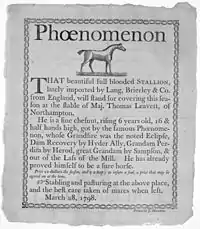Ephemera
Ephemera are any transitory written or printed matters that are not meant to be retained or preserved. The word derives from the Greek ephemeros, meaning "lasting only one day, short-lived".[1] Some collectible ephemera are advertising, trade cards, airsickness bags, bookmarks, catalogues, greeting cards, letters, pamphlets, postcards, posters, prospectuses, defunct stock certificates or tickets, and zines.
| Collecting |
|---|
| Terms |
| Topics |
Etymology
Ephemera (ἐφήμερα) is a noun, the plural neuter of ephemeron and ephemeros, Greek and New Latin for epi (ἐπί) – "on, for" and hemera (ἡμέρα) – "day". The ancient sense extended to the mayfly and other short lived insects and flowers, and for something which lasts a day or a short period of time.[2]
Printed ephemera
In library and information science, the term ephemera also describes the class of published single-sheet or single page documents which are meant to be thrown away after one use. This classification excludes simple letters and photographs with no printing on them, which are considered manuscripts or typescripts. Large academic and national libraries and museums may collect, organize, and preserve ephemera as history. A particularly large and important example of such an archive is the John Johnson Collection of Printed Ephemera[3] at the Bodleian Library, Oxford. Over 2,000 images from the John Johnson Collection are available to search online for free at VADS[4] and more than 65,000 items are available online.[5] The extensive Laura Seddon Greeting Card Collection from the Manchester Metropolitan University gathers 32,000 Victorian and Edwardian greeting cards and 450 Valentine's Day cards dating from the early nineteenth century, printed by the major publishers of the day.[6] The Ephemera Kabinett at the Los-Angeles–based Institute of Cultural Inquiry contains 'first' items from cultural turning points of the last two decades, such as a copy of the first Marvel comic in which a lead character comes out of the closet and one of the first AIDS red ribbons.[7]
Video and audio ephemera
By extension, video ephemera and audio ephemera refer to transitory audiovisual matter not intended to be retained or preserved. Surprisingly, the great bulk of video and audio expression has, until recently, been ephemeral. Early TV broadcasts were not preserved (indeed, the technology to preserve them postdates the invention of television, and even after such technology came into use in the 1950s, much of the content of programming not in prime time was destroyed for economic reasons well into the 1970s). Even if radio and television stations preserve archives of their broadcasts, those backcatalogs are inaccessible in practice to the general public, leaving it to a small number of underground tape traders to exchange the rare, lucky moments when something unexpected or historical came across the air.
An article on the Ephemera Society of America website notes
Printed ephemera gave way to audio and video ephemera in the twentieth century. ... These present even more of a preservation problem than printed materials. Although seldom made available for libraries, when videotapes are acquired for archival preservation they are found to be made on low quality tape, poorly processed, and damaged from abuse by users.[8]
The large capacity and reach provided by resources such as the Internet Archive and YouTube have made finding and sharing video ephemera (past and present) dramatically easier.
Collecting
As ephemera are items that are not supposed to be retained, they are easily accessible and attractive for collectors. Most of them can be obtained by asking either family members or friends to save it. Printed ephemera usually contain various promotional images and texts. Different themes, types, sizes, and shapes make these items perfect for collecting. Online collector catalogs exist to showcase different types of ephemera and provide information to enthusiasts.[9]
Notes
- http://www.dictionary.com/browse/ephemera
- "Ephemera". The Free Dictionary. Retrieved 6 October 2016.
- Bodley.ox.ac.uk
- VADS (the Visual Arts Data Service)
- Johnjohnson.chadwyck.co.uk
- "MMU Special Collections - Victorian Ephemera". Manchester Metropolitan University. Retrieved November 8, 2013.
- Florenkowsky, Emilie. "Inquiry into the Institute of Cultural Inquiry." Meta magazine, 2011.
- ""'I Like Ike': Collecting Political Ephemera", Faye Philips". Archived from the original on 2008-04-24. Retrieved 2008-03-13.
- SAPO. "Coleciona "coisas"? Organize e partilhe com o Colnect". SAPO Tek (in Portuguese). Retrieved 2019-04-03.
References
- Printed Ephemera: The Changing Uses of Type and Letterforms in English and American Printing, John Lewis, Ipswich, Suffolk, Eng.: W. S. Cowell, 1962
- The Encyclopedia of Ephemera: A Guide to the Fragmentary Documents of Everyday Life for the Collector, Curator, and Historian by Maurice Rickards et alia. London: The British Library; New York: Routledge, 2000.
- Fragments of the Everyday: A Book of Australian Ephemera by Richard Stone (2005, ISBN 0-642-27601-3)
- Twyman, Michael (August 2002). "Ephemera: whose responsibility are they?". Library and Information Update. 1 (5): 54–55. ISSN 1476-7171.
External links
| Look up ephemeron in Wiktionary, the free dictionary. |
| Wikimedia Commons has media related to Ephemera. |
- Ephemera Society of Australia
- The Ephemera Society
- Ephemera Society of America
- Printed Ephemera in the Rare Book and Special Collections Division of the Library of Congress
- Australian Lesbian and Gay Archives – Ephemera Collection
- National Library of Australia – Ephemera Collection
- The Gjenvick-Gjønvik Archives – Ephemera Collection
- British Library – Evanian Collection of Ephemera
- State Library of Victoria – Ephemera
- State Library of Western Australia – Ephemera
- The John Grossman Collection of Antique Images
- New Zealand Ephemera Society website
- Bibliothèque Nationale de France – Ephemera
- ephemerastudies.org at Louisiana Tech University
- Sheaff, Dick. "Sheaff: Ephemera". Ephemera. Retrieved 12 December 2011.
- Collection of digitized ephemera at Biblioteca Digital Hispánica, Biblioteca Nacional de España
- Ephemerajournal. theory & politics of organization
